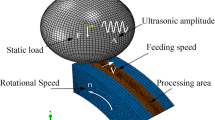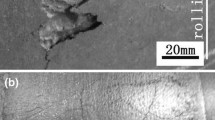Abstract
Based on Gaussian random function, the micro-contact model of spherical roller bearing is established by reverse engineering, and the contact states of surfaces with different roughness are calculated. The contact characteristics of contact surface such as equivalent stress, contact stress, contact area ratio and relative fatigue life are studied. Then, the accuracy of finite element calculation is verified by rough surface contact experiment. The results show that with the increase of displacement load, the equivalent stress and contact stress of contact surface increase, and the contact area ratio of rough contact surface increases steadily. With the decrease of roughness, the fatigue life of contact surface increases slightly. When the contact surface is close to smooth, the fatigue life of the contact surface is significantly improved, and the equivalent stress is significantly reduced: as the roughness of the contact surface is close to the target surface, the contact stress of the contact surface is significantly reduced. The results show that the roughness surface Ra = 0.05 μm has good performance in the aspects of equivalent stress, contact area and fatigue life. The contact stress of the roughness surface Ra = 0.4 μm has a minimum value, which provides a reference for selecting the machining accuracy of the contact surface of spherical roller bearings.

















Similar content being viewed by others
Abbreviations
- Ra:
-
Contour arithmetic mean deviation
- Rz:
-
Contour maximum height
- A * :
-
The height data of rough surface
- p :
-
The value of Ra of the reference contour
- z :
-
Variance
- M :
-
Matrix
- X′, Y′, Z′:
-
The three-way coordinates of the rough surface
- Rsm:
-
The spacing characteristic parameter
- x′, y′, z′:
-
The three-way coordinates of the smooth surface
- ρ :
-
Density
- E :
-
Elastic modulus
- μ :
-
Poisson’s ratio
- Rm:
-
Tensile strength
- σ s :
-
Yield strength
- K :
-
The probability of survival
- N :
-
The number of stress cycles
- e :
-
The slope of Weibull distribution
- V :
-
The volume obtained by integrating the stress
- τ eq :
-
Von Mises stress
- f :
-
The stress index
- σ 1 :
-
The first principal stress
- σ 2 :
-
The second principal stress
- σ 3 :
-
The third principal stress
- N 1 :
-
The stress cycles of smooth surface
- N 2 :
-
The stress cycles of rough surface
- L r :
-
The fatigue life
- ΔS :
-
The displacement load
- δ :
-
The contact area rate
- a, b :
-
The value factors of the formula, corresponding to different roughness fitting formulas.
- x :
-
The force response value
- f(x) :
-
The equivalent stress value
References
Li L, Yun QQ, Tian HF (2011) Investigation into the contact characteristics of rough surfaces with surface tension. J Braz Soc Mech Sci Eng 41:343. https://doi.org/10.1007/s40430-019-1847-z
Jiling C, Jinyuan T, Duo Y (2022) Sensitivity analysis of tooth surface roughness parameters and contact stress. J Northwest Polytech Univ 40(04):883–891
Wang S, Yao XF, Yang H (2019) Measurement and evaluation on contact stress at the rubber contact interface. Measurement 146:856–867. https://doi.org/10.1016/j.measurement.2019.07.018
Xun S, Wei W, Kun L (2020) Construction of finite element model and contact analysis of microscopic random rough surface. Lubr Eng 45(05):25–29
Olshevskiy A, Yang HI, Kim C-W (2012) Finite element simulation of inelastic contact for arbitrarily shaped rough bodies. Proc IMechE Part C J Mech Eng Sci 226(C3):595–606. https://doi.org/10.1177/0954406211417216
Chen H, Chen Y, Yang Yi (2014) A fatigue and low-energy shock-based approach to predict fatigue life. J Mech Sci Technol 28:3977–3984
Greerwood JA, Willimson JBP (1966) Contact of naminally flat surfaces. Proc Royal Soc A295:300–319
Yuan Y, Gan L, Liu K (2017) Elastoplastic contact mechanics model of rough surface based on fractal theory. Chin J Mech Eng 30(1):207–215
Majumdar A, Bhushan B (1990) Role of fractal geometry in roughness characterization and contact mechanics of surfaces. ASME J Tribol 112:205–216
Majumdar A, Bhushan B (1991) Fractal model of elastic-plastic contact between rough surfaces. ASME J Tribol 113:1–11
Mallat SG (1989) A theory for multiresolution signal decomposition: the wavelet representation. IEEE Trans Pattern Anal Mach Intell 11(7):674–693
Jesrer P, Menke C, Urban K (2012) Wavelet methods for the representation, analysis and simulation of optical surfaces. IMA J Appl Math 77(4):495–515. https://doi.org/10.1093/imamat/hxr030
Shu wen R, Xian ming L, Xiao hua L (2022) Measurement of three-dimensional virtual image of head up display based on binocular vision. J Opt 42(19):58–65
Yong wu Z, Yan ming Lv, Jian zhong J (2007) A new elastoplastic contact model for rough surfaces. Chin J Mech Eng. 43(3):95–101
Run qiong W, Li da Z, Chun xia Z (2018) Research on contact stiffness model of joint surface based on interaction between domain expansion factor and micro-convex body. J Mech Eng 54(19):88–95
Yu YJ, Cui Y, Zhang HX (2022) Considering the deformation of base metal static seal asperity contact model. Tribology 43(4):1–13
Lee J, Beheshti A, Polycarpou A (2017) A rough surface normal nanocontact stiffness: experimental measurements and rough surface contact model predictions. J Appl Mech-Trans ASME 84(3):031006. https://doi.org/10.1115/1.4035524
Zhao G, Li Y, Zhang Z (2022) Simulation and experiment of secondary contactstiffness of rough surface. J Mech Sci Technol 36:1079–1087
Zhai CP, Hanaor D, Proust G (2017) Stress-dependent electrical contact resistance at fractal rough surfaces. J Eng Mech. https://doi.org/10.1061/(ASCE)EM.1943-7889.0000967
Shao lei Wu, Feng Yu, Kai Wu (2018) Construction and simulation analysis of 3D rough surface electrical contact model based on finite element. J Hefei Univ Technol (Nat Sci Edition) 9(11):1441–14455
Wilson WE, Angadi SV, Jackson RL (2011) Surface separation and contact resistance considering sinusoidal elastic-plastic multi-scale rough surface contact. Wear 268(1–2):190–201. https://doi.org/10.1016/j.wear.2009.07.012
Bennett AL, Schulze HKL (2017) Contact measurements of randomly rough surfaces. Tribol lett. https://doi.org/10.1007/s11249-017-0918-5
Jamal M, Morgan MN (2017) Materials characterization part I: contact area of the Berkovich indenter for nanoindentation tests. Int J Adv Manuf Technol 92:361–370. https://doi.org/10.1007/s00170-017-0115-6
Wu SL, Feng Y, Wu K (2018) Construction and simulation analysis of 3D rough surface electrical contact model based on finite element. J HEFEI Univ Technol 41(11):1441–1445
Acknowledgements
Ming Chen performed the data analyses and wrote the manuscript; Qiang Bian performed the experiment and data analyses; Guang Zeng contributed significantly to analysis and manuscript preparation; Chunjiang Zhao helped perform part of the finite element analysis. Lianyun Jiang contributed to the conception of the study; Xiangyun Zhang helped perform the analysis with constructive discussions; Bowen Jiao helped perform the chart.
Funding
This research work supported by National Natural Science Foundation of China (No.20201102003), Key Research and Development Projects in Shanxi province (grant number 201903D421031), National Natural Science Foundation of China (No. 51375325).
Author information
Authors and Affiliations
Corresponding author
Ethics declarations
Conflict of interest
The authors declare no competing interests.
Additional information
Technical Editor: Jarir Mahfoud.
Publisher's Note
Springer Nature remains neutral with regard to jurisdictional claims in published maps and institutional affiliations.
Rights and permissions
Springer Nature or its licensor (e.g. a society or other partner) holds exclusive rights to this article under a publishing agreement with the author(s) or other rightsholder(s); author self-archiving of the accepted manuscript version of this article is solely governed by the terms of such publishing agreement and applicable law.
About this article
Cite this article
Chen, M., Bian, Q., Zeng, G. et al. Rough surface modeling and contact analysis based on micro-scale spherical roller bearing. J Braz. Soc. Mech. Sci. Eng. 45, 616 (2023). https://doi.org/10.1007/s40430-023-04530-1
Received:
Accepted:
Published:
DOI: https://doi.org/10.1007/s40430-023-04530-1




